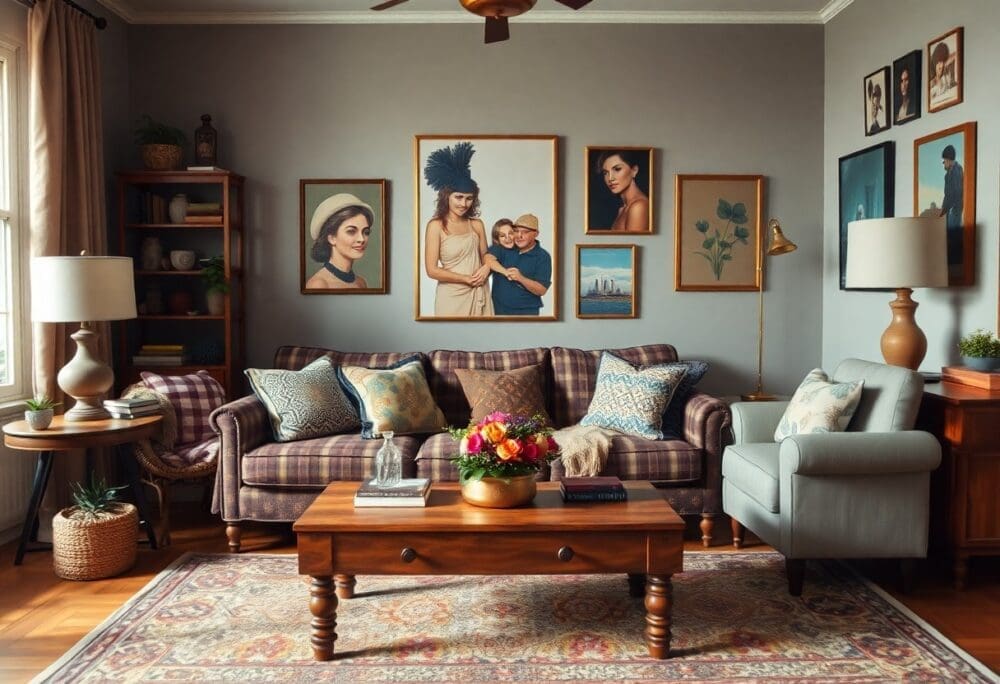There’s a world of creativity waiting for you when it comes to mixing and matching home decor. By understanding the principles of color, pattern, and texture, you can create a harmonious yet dynamic living space that reflects your personal style. In this blog post, you will discover necessary tips that empower you to confidently combine different elements to achieve a cohesive look that feels uniquely yours. Get ready to transform your home into a stunning showcase of your individuality!
Key Takeaways:
- Choose a cohesive color palette that incorporates complementary hues, allowing various decor pieces to harmoniously blend together.
- Mix different textures and materials, such as wood, metal, and fabric, to create depth and interest in your space.
- Balance scale and proportion by varying the sizes of furniture and decor items, ensuring that the arrangement feels visually appealing and functional.
Understanding Color Theory
Your understanding of color theory can significantly enhance your home decor. By grasping how colors interact and evoke emotions, you can create a harmonious and visually appealing space. Color choices can influence the mood of a room, making it vital to study color relationships and their psychological effects on your design choices.
The Basics of Color Combinations
At the core of effective design is a solid grasp of color combinations. Primary, secondary, and tertiary colors form the foundation of any color palette. You can create cohesive looks by using complementary, analogous, or monochromatic schemes, balancing contrast and harmony to achieve your desired aesthetic.
Using a Color Wheel to Your Advantage
Any savvy designer understands the power of the color wheel. By familiarizing yourself with this tool, you can easily identify which colors work well together and which may clash. This knowledge allows you to confidently mix and match hues, resulting in visually stunning decor that resonates with your personal style.
Indeed, a color wheel is your best friend when it comes to selecting the perfect palette for your space. It categorizes colors into warm and cool tones, providing insight into how they affect each other. By exploring analogous colors for a serene ambiance or complementary colors to create vibrant contrast, you can make informed choices that elevate your design. Use the wheel as a guide, and don’t hesitate to experiment with different combinations to discover what resonates with you and your home.
Choosing a Style
If you want to create a harmonious home atmosphere, selecting a distinct style is important. Start by exploring various influences and inspirations, whether it’s a modern, rustic, or eclectic vibe. For tips on how to mix and match furniture styles for a cohesive home, consider how elements can blend seamlessly while reflecting your unique taste.
Identifying Your Personal Aesthetic
Identifying your personal aesthetic is the first step to achieving a decor style that feels right for you. Take time to gather inspiration from magazines, online platforms, or even your surroundings. This will help you recognize the colors, patterns, and textures that resonate with your preferences, allowing you to cultivate a space that feels authentically yours.
Blending Different Design Styles
Blending different design styles adds depth and character to your home. Start by selecting a dominant style that speaks to you, then introduce elements from other styles to create an eclectic yet cohesive look. This can be done through varied furniture pieces, art, and accessories, allowing for a layered aesthetic that enhances your interior space.
Also, consider creating a color palette that encompasses shades from both styles to establish unity throughout your home. Use a common element, like a shape or texture, in both styles to create harmony. Play around with scales and proportions to ensure that different styles complement rather than compete with each other, leading to an inviting atmosphere that reflects your personality.
Textures and Materials
All great home decor combines various textures and materials to create a visually appealing and harmonious environment. By thoughtfully layering different elements, you can transform your space, adding both warmth and personality. Consider blending soft fabrics with more rigid surfaces, allowing for an engaging tactile experience that draws the eye and invites touch.
Complementary Textures for Depth
Across your decor, using a mix of complementary textures is key to creating depth. Combine smooth and rough surfaces, like a velvet sofa paired with a reclaimed wood coffee table. Such contrasts enhance your decor’s overall interest and can make a room feel more dynamic and inviting.
Balancing Materials in Your Decor
About balancing materials, this ensures that no single element overpowers the others in your space. Prioritize a thoughtful mix of metal, wood, glass, and fabric throughout your decor to create a well-rounded aesthetic. By evenly distributing these materials, you can maintain a sense of cohesion and harmony within your home.
In fact, achieving a balance among materials not only enhances the visual appeal of your space but also dictates the emotional atmosphere. By selecting materials that work harmoniously together, you can invite warmth and comfort, making your home a welcoming retreat. Pay attention to the weight and shine of each material, and strive for a blend that feels both cohesive and inviting.
Scale and Proportion
Not all furniture and decor items are created equal; understanding scale and proportion is key to achieving a harmonious space. When mixing various elements, consider their size relative to the entire room. Oversized pieces can overwhelm a small room, while too many small decor items can leave larger spaces feeling sparse. Striking the right balance helps create an inviting atmosphere.
Understanding the Importance of Scale
To create visually appealing and functional spaces, it’s imperative to grasp the relationship between the size of your furniture and the dimensions of your rooms. Your eye naturally seeks balance, so ensuring that your scale is appropriate can enhance the overall aesthetic. By evaluating the size of each piece in relation to others in the space, you can curate an environment that feels cohesive and thoughtfully designed.
Creating Balance with Proportions
Around your space, proportions play a pivotal role in achieving visual harmony. Use a mix of large, medium, and small items to create layers and depth. Keeping proportions in mind when selecting decor can help each piece interact positively with its surroundings, effectively guiding the viewer’s eye throughout the room.
Another way to enhance proportions is by grouping items of varying heights or sizes together. For instance, a tall floor lamp next to a low coffee table can create dynamic visual interest. Consider also the negative space around your decor; this “breathing room” allows each piece to shine without feeling crowded. Experimenting with these concepts will lead you to a more balanced and inviting space.
Focal Points and Arrangement
Once again, establishing a focal point in your room enhances the overall aesthetic and creates visual interest. Consider how your main decorative element draws the eye and influences the surrounding decor. Whether it’s a piece of art, a stunning piece of furniture, or a striking architectural feature, your focal point should set the tone for the space and guide the arrangement of other elements within the room.
Designing Eye-Catching Focal Points
Focal points are crucial for a well-coordinated interior, providing a visual anchor that captures attention. To design an eye-catching focal point, choose a statement piece that reflects your personal style and complements the room’s overall decor. Position it strategically, ensuring no other element competes for attention, and consider integrating varied textures and colors to enhance its appeal.
Effective Furniture Arrangement Techniques
After identifying your focal point, the next step is to arrange your furniture effectively around it. This ensures that your space is both functional and visually appealing, allowing for comfortable conversation and flow. Assess your room’s dimensions and layout, and consider how each piece interacts with both the focal point and each other.
Furniture placement can transform a room’s atmosphere. Start by defining conversation areas; place seating in a way that encourages interaction, circling around the focal point without blocking pathways. Use rugs to establish zones and create balance between larger and smaller pieces, ensuring that the arrangement feels cohesive. Also, consider the scale of your furniture. Larger pieces should be balanced with smaller items to prevent overwhelming the space, while maintaining a harmonious visual flow.
Accessorizing with Purpose
Despite the temptation to fill your space with items that catch your eye, accessorizing with purpose can make a significant impact on your home decor. Each piece should not only reflect your personal style but also enhance the overall aesthetic of your space. By focusing on how accessories contribute to the theme and function of a room, you create a harmonious environment that feels curated and intentional.
Selecting Accessories that Enhance
One of the keys to effective accessorizing is choosing pieces that enhance your existing decor while harmonizing with your style. Opt for accessories that complement your color palette and materials, creating a cohesive look that pulls the room together. Think carefully about the scale and proportion of each item, ensuring they fit seamlessly in the spaces you wish to enhance.
Layering Accessories for Visual Interest
Behind every captivating space is the art of layering accessories to create visual interest and depth. This technique allows you to play with dimensions, textures, and colors, enriching your decor and inviting exploration.
But layering goes beyond just stacking items; it’s about creating a narrative with your accessories. Begin with larger, foundational pieces, then add medium-sized elements and finally, finish with smaller details that draw the eye. Mixing textures like glass, metal, and fabric adds richness to your display, while varying heights ensures a dynamic composition. Incorporating personal items, such as photographs or travel mementos, not only adds uniqueness but also tells your story, making your space feel alive and personal.
Final Words
On the whole, mastering the art of mixing and matching home decor allows you to create a space that reflects your personal style. By focusing on a cohesive color palette, incorporating various textures, and balancing different patterns, you can achieve a harmonious look. Don’t hesitate to experiment with unique elements while ensuring they complement each other. Your home should tell your story, so let your creativity shine through your decor choices, making each room a true reflection of you.
FAQ
Q: What are some basic principles for mixing different patterns in home decor?
A: When mixing patterns in your home decor, it’s important to maintain a balance. Start by choosing a color palette that ties the patterns together. Aim for a mix of various scales—pair large patterns with smaller ones to create visual interest without overwhelming the space. Additionally, try to include a solid color or neutral item to anchor the scheme. This approach helps to create harmony while still allowing your personality to shine through in the decor.
Q: How can I effectively use color when blending decor styles?
A: Using color thoughtfully allows you to effectively blend different decor styles. Start by selecting a dominant color that resonates with both styles, then introduce complementary accents throughout the space. For example, if you’re combining traditional and modern elements, a rich navy could serve as your base, while metallic and vibrant hues act as accent colors. This will create a cohesive look that feels intentional rather than chaotic. Be mindful of how colors interact and consider incorporating varying shades of the same hue for added depth.
Q: What are some tips for incorporating vintage pieces into a modern decor scheme?
A: Incorporating vintage pieces into a modern decor scheme can add character and charm to your space. Start by selecting a few standout vintage items that you truly love. Make sure they contrast well with your modern elements; for instance, a mid-century coffee table can complement a sleek, contemporary sofa. Balance is key, so group your vintage finds together or pair them with modern items to showcase their unique qualities. Finally, consider the finish and material of your vintage pieces—mixing wood with metal or glass can create an eclectic yet harmonious look.





